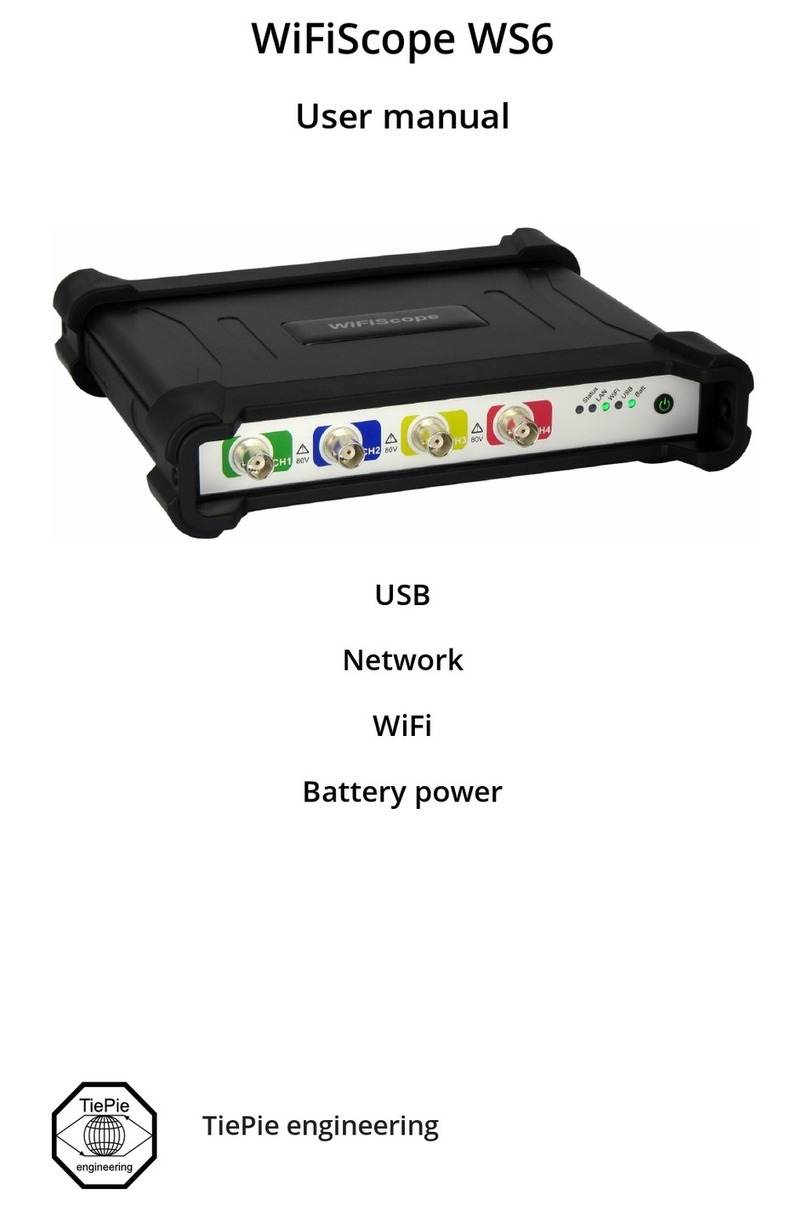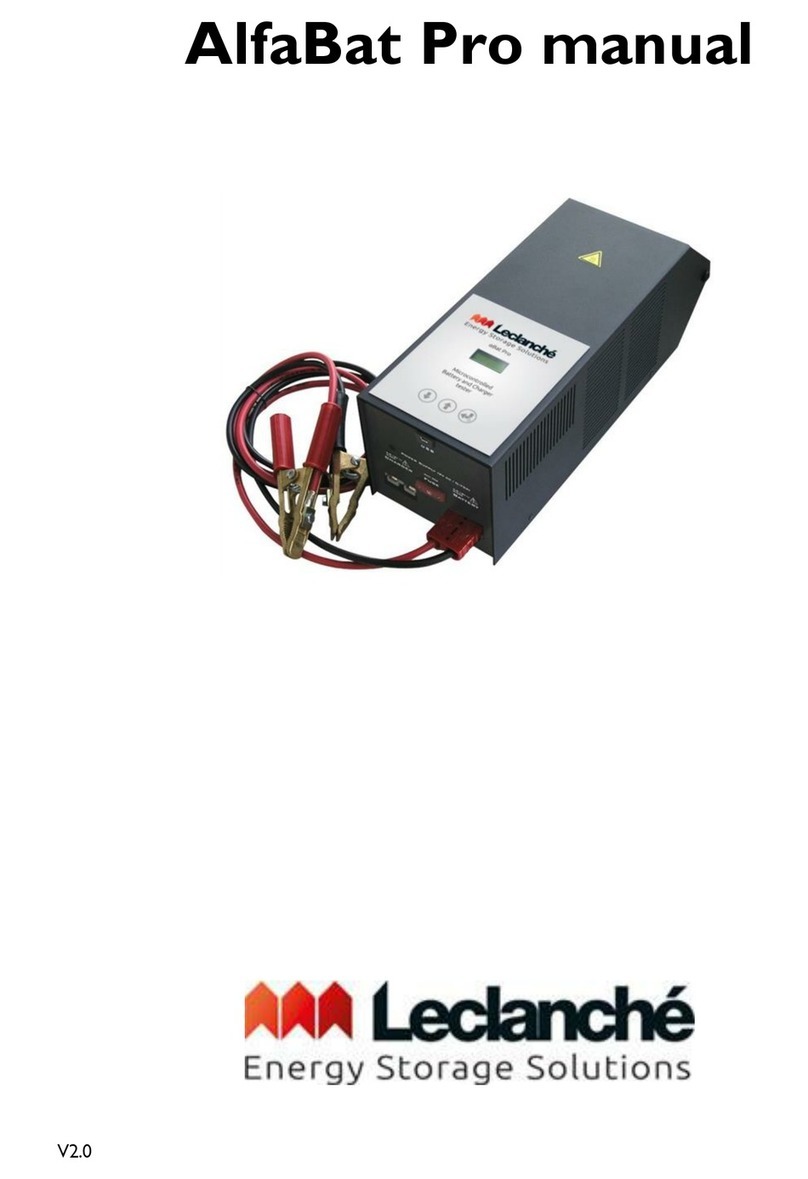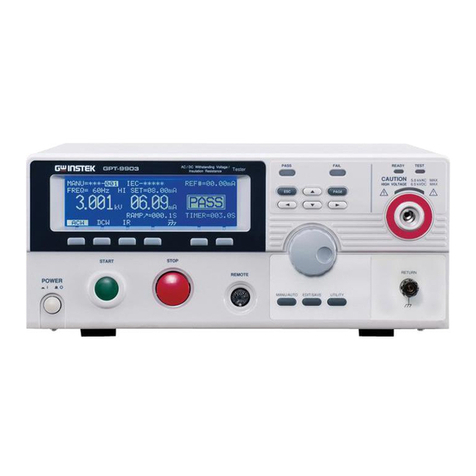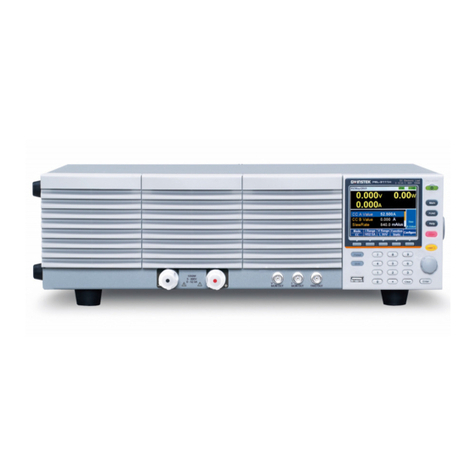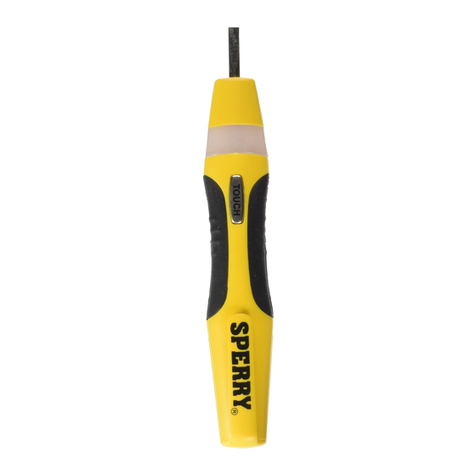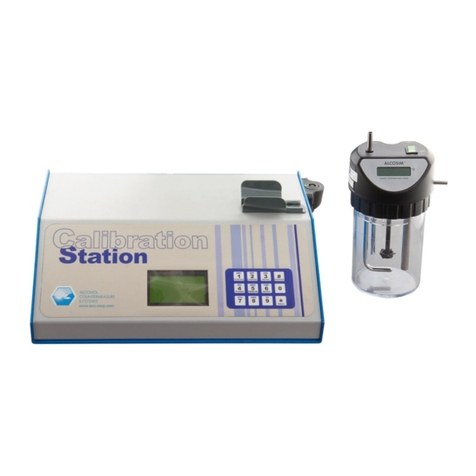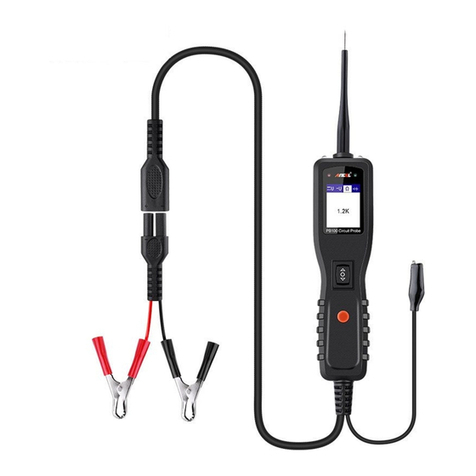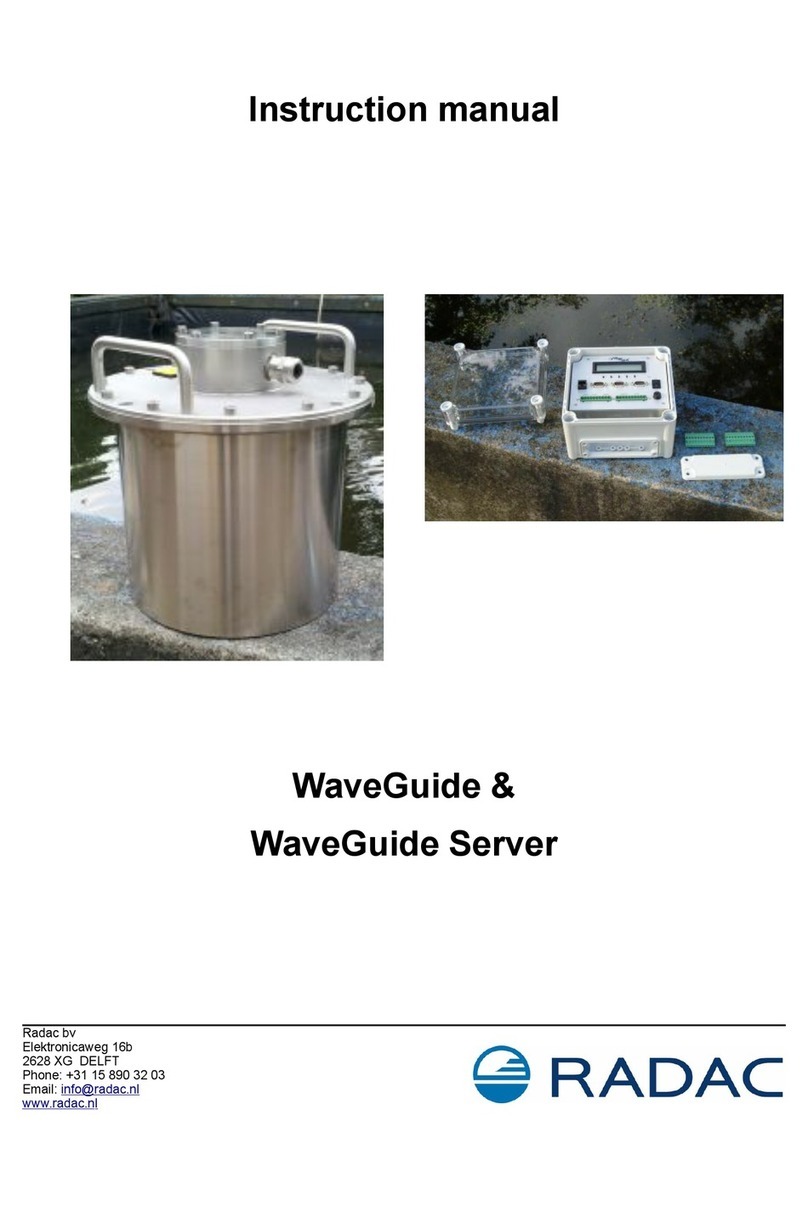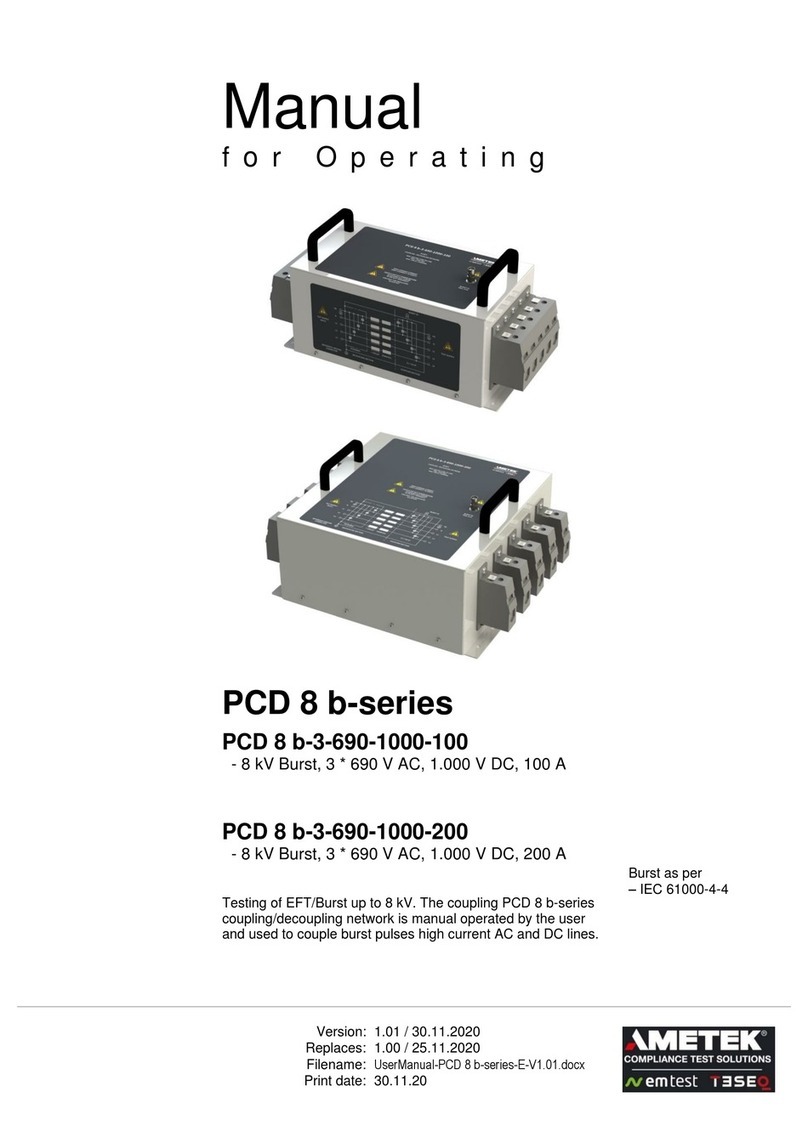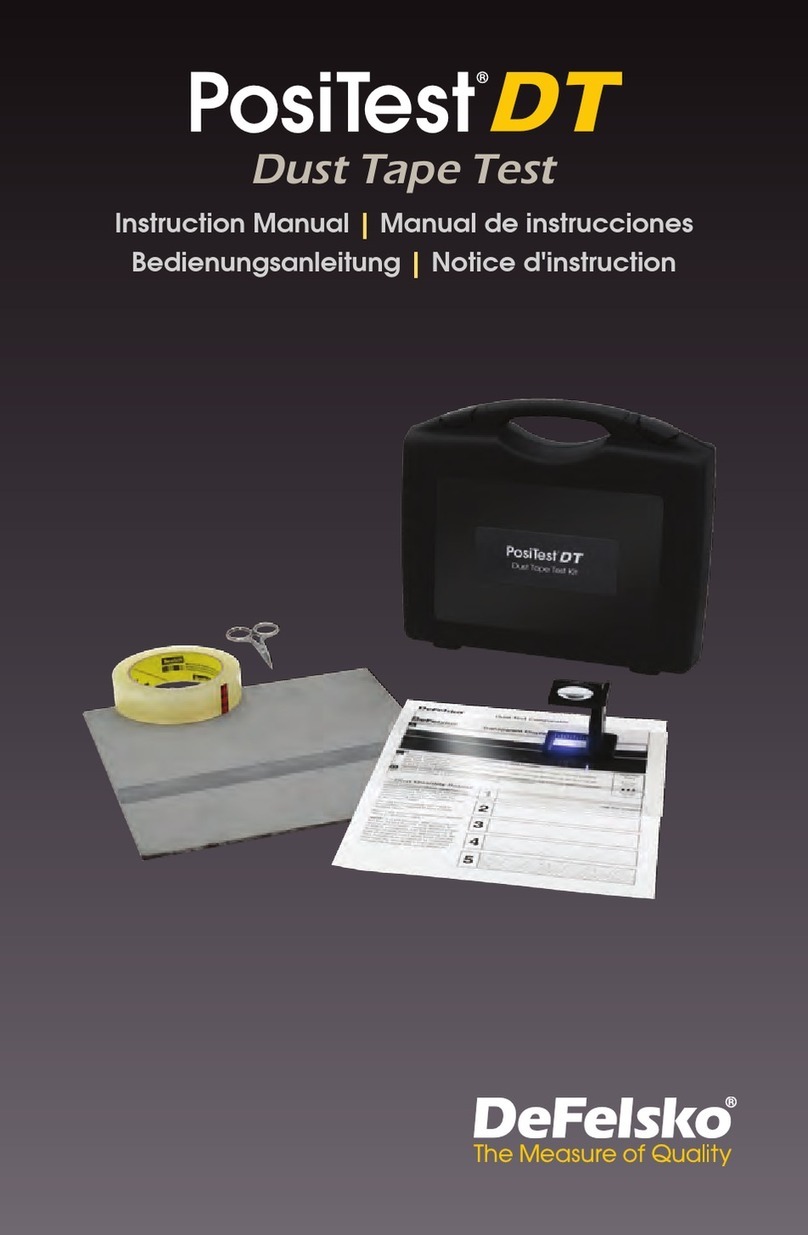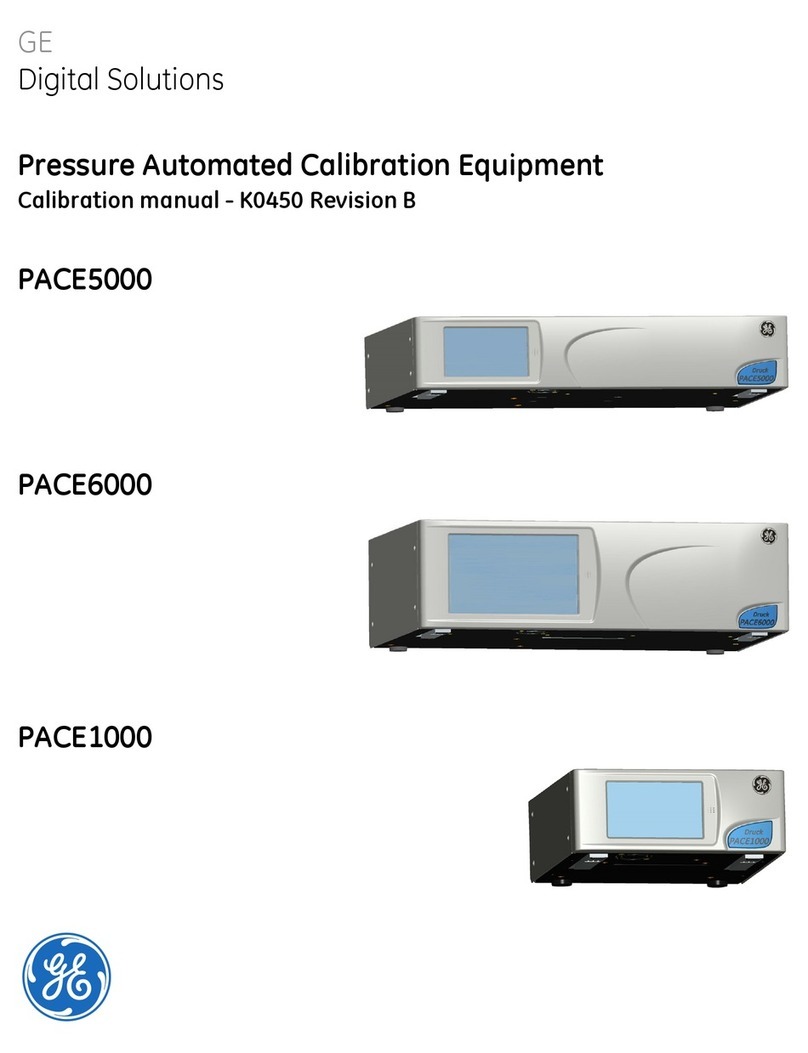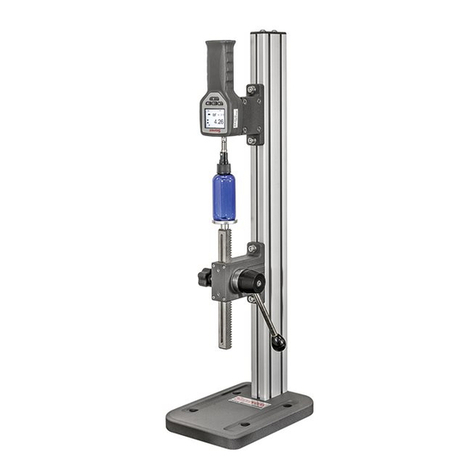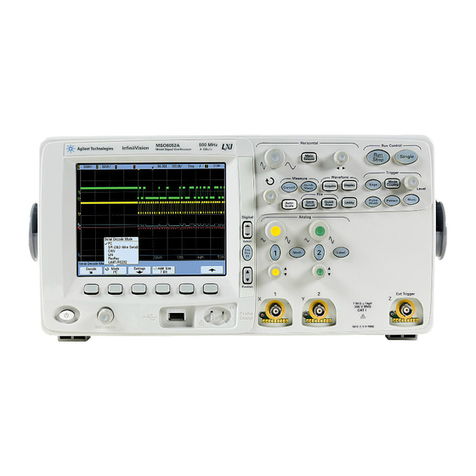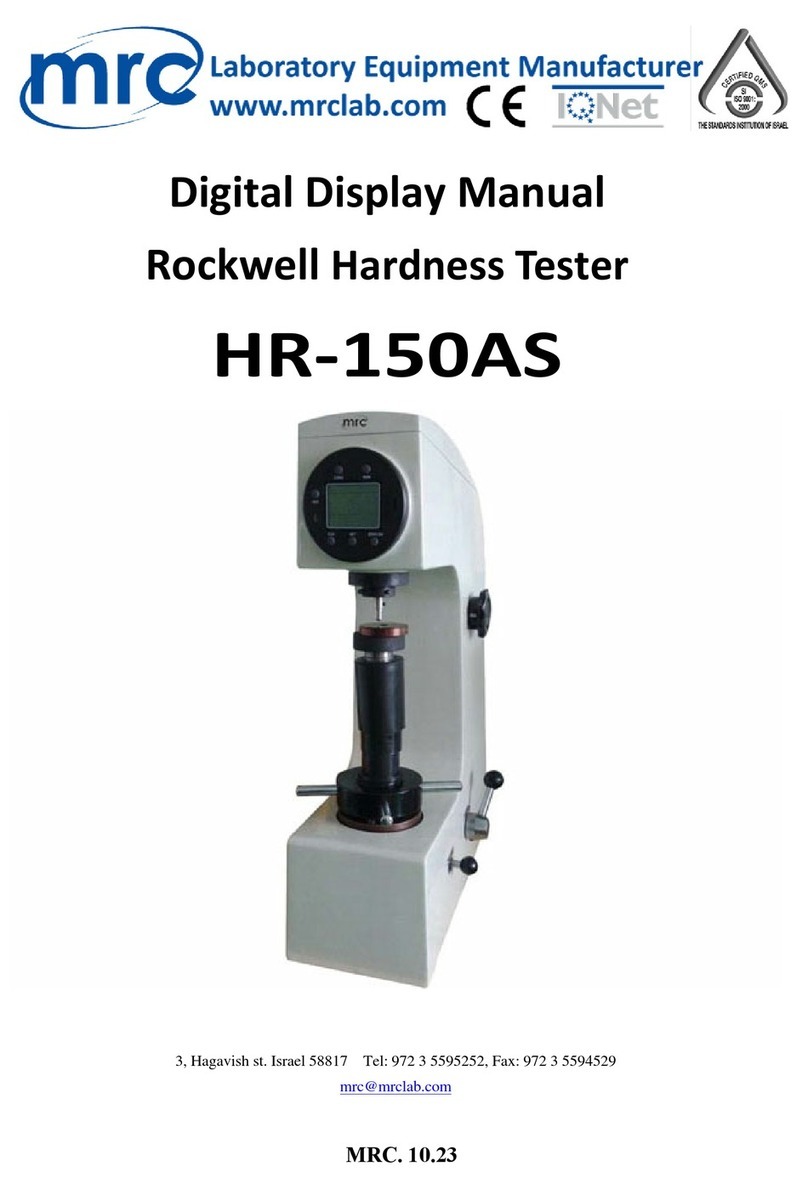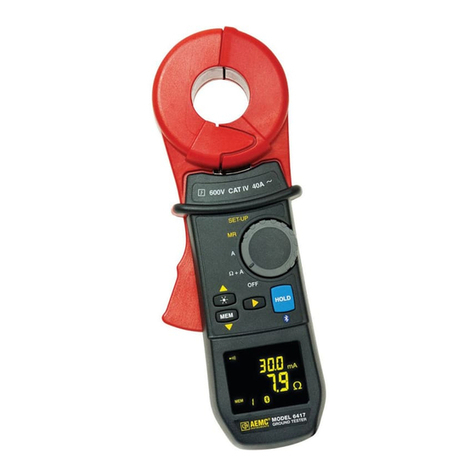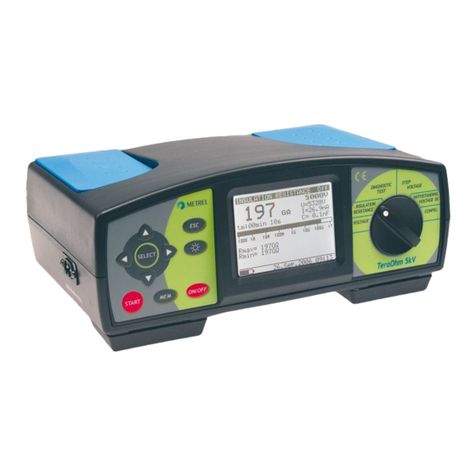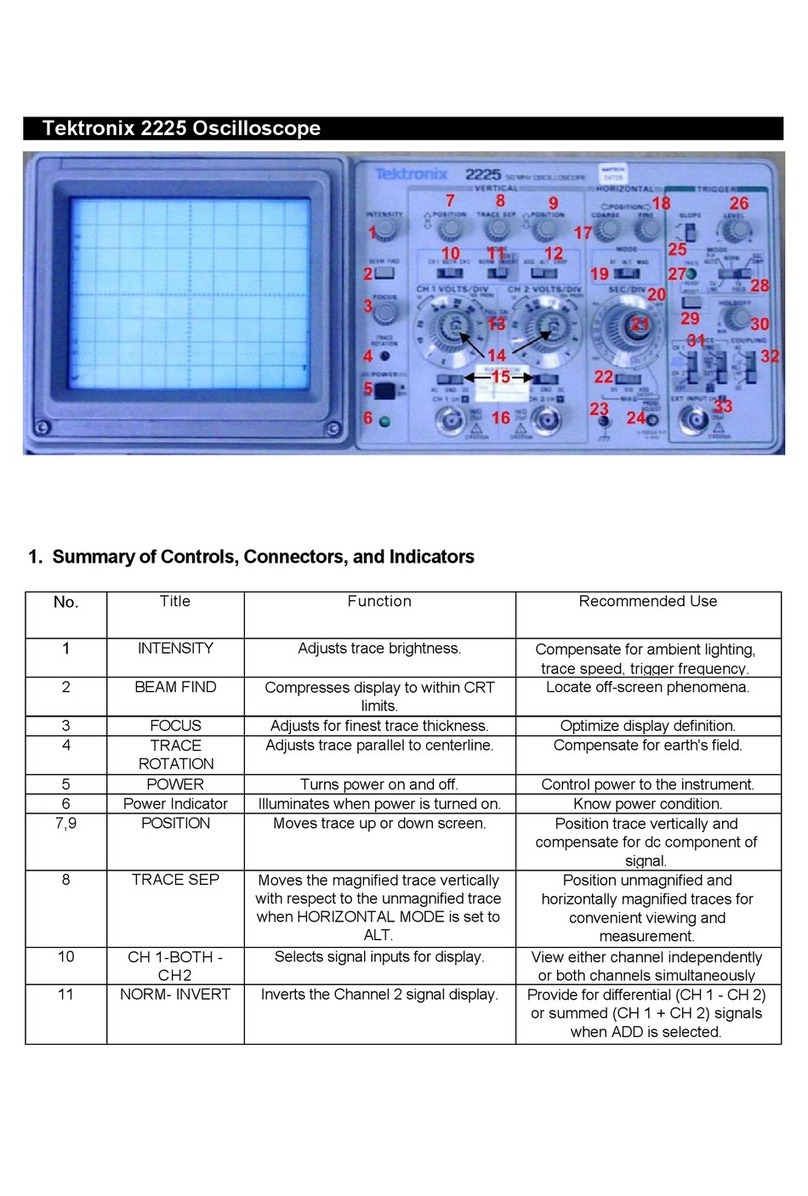Tintometer Lovibond MD100 User manual


NL Handboek van Methoden 01/20EN Handbook of Methods 01/20
KS4.3 T
0.1 - 4 mmol/l KS4.3
Acid / Indicator
20
S:4.3
Instrument specific information
The test can be performed on the following devices. In addition, the required cuvette
and the absorption range of the photometer are indicated.
Instrument Type Cuvette λMeasuring Range
MD 200, MD 600, MD 610,
MD 640, MultiDirect, PM 620,
PM 630
ø 24 mm 610 nm 0.1 - 4 mmol/l KS4.3
SpectroDirect, XD 7000,
XD 7500
ø 24 mm 615 nm 0.1 - 4 mmol/l KS4.3
Material
Required material (partly optional):
Reagents Packaging Unit Part Number
Alka-M-Photometer Tablet / 100 513210BT
Alka-M-Photometer Tablet / 250 513211BT
Application List
• Waste Water Treatment
• Drinking Water Treatment
• Raw Water Treatment
Notes
1. The terms Alkalinity-m, m-Value, total alkalinity and Acid demand to KS4.3 are iden-
tical.
2. For accurate results, exactly 10 ml of water sample must be used for the test.
Display in the MD
100 / MD 110 /
MD 200
Bar code for the
detection of the
methods
Method name
Measuring range
Chemical Method
Method number
Language codes
ISO 639-1 Revision status
KS4.3 T / 20
How to use
ENHandbook of Methods4
EN

Implementation of the provision Acid capacity KS4.3 with Tablet
Select the method on the device
For this method, no ZERO measurements are to be carried out with the following de-
vices: XD 7000, XD 7500
10 ml
Fill 24 mm vial with 10 ml
sample.
Close vial(s).
Sample
Place sample vial in the
sample chamber. • Pay
attention to the positioning.
Dissolve tablet(s) by inver-
ting.
Sample
Place sample vial in the
sample chamber. • Pay
attention to the positioning.
Test
Press the TEST (XD:
START)button.
The result in Acid Capacity KS4.3 appears on the display.
Performing test
procedure
KS4.3 T / 20
NL Handboek van Methoden 01/20EN Handbook of Methods 01/20
How to use
ENHandbook of Methods 5
EN

Ammonia T / M60
ENMethod Reference Book1.06
EN
Ammonia T M60
0.02 - 1 mg/l N A
Indophenole Blue
Material
Required material (partly optional):
Reagents Packaging Unit Part Number
Ammonia No. 1 Tablet / 100 512580BT
Ammonia No. 1 Tablet / 250 512581BT
Ammonia No. 2 Tablet / 100 512590BT
Ammonia No. 2 Tablet / 250 512591BT
Set Ammonia No. 1/No. 2 100 Pc.#100 each 517611BT
Set Ammonia No. 1/No. 2 250 Pc.#250 each 517612BT
Ammonia Conditioning Powder Powder / 15 g 460170
Preperation
1. Sea water samples:
Ammonia conditioning reagent is required when testing sea water or brackish water
samples to prevent precipitation (settlement) of salts.
Fill the test tube with the sample to the 10 ml mark and add one level spoonful of
Aluminium Conditioning Powder. Close the vials with the caps and swirl until the
powder has dissolved. Then proceed as described.
Notes
1. The AMMONIA No. 1 tablet will only dissolve completely after the AMMONIA No. 2
Tablet has been added.
2. The temperature of the sample is important for full colour development. At
temperatures of below 20 °C the reaction period is 15 minutes.

Ammonia T / M60
ENMethod Reference Book1.0 7
EN
Implementation of the provision Ammonium with Tablet
Select the method on the device
10 ml
Sample
Fill 24 mm vial with 10 ml
sample.
Close vial(s). Place sample vial in the
sample chamber. • Pay
attention to the positioning.
Zero
Press the ZERO button. Remove the vial from the
sample chamber.
24 mm
Add AMMONIA No.
1 tablet .
Crush tablet(s) by rotating
slightly.
Add AMMONIA No.
2 tablet .

Ammonia T / M60
ENMethod Reference Book1.08
EN
24 mm
Crush tablet(s) by rotating
slightly.
Close vial(s). Dissolve tablet(s) by
inverting.
Sample
Test
9
4
5
6
7
8
10
11 12
1
2
3
10 min
Place sample vial in the
sample chamber. • Pay
attention to the positioning.
Press the TEST (XD:
START)button.
Wait for 10 minute(s)
reaction time.
Once the reaction period is finished, the measurement takes place automatically.
The result in mg/l Ammonium appears on the display.

Ammonia T / M60
ENMethod Reference Book1.0 9
EN
Analyses
The following table identifies the output values can be converted into other citation
forms.
Unit Cite form Scale Factor
mg/l N 1
mg/l NH41.2878
mg/l NH31.2158
Chemical Method
Indophenole Blue
Appendix
Interferences
Persistant Interferences
• Sulphides, cyanides, rhodanide, aliphatic amine and aniline interfere in higher
concentrations.
Bibliography
Photometrische Analyseverfahren, Schwendt, Wissenschaftliche Verlagsgesellschaft
mbH, Stuttgart 1989
According to
APHA Method 4500-NH3 F
# including stirring rod, 10 cm

Ammonia PP / M62
ENMethod Reference Book1.010
EN
Ammonia PP M62
0.01 - 0.8 mg/l N A
Salicylate
Material
Required material (partly optional):
Reagents Packaging Unit Part Number
VARIO Ammonia Nitrogen, Set F10 1 Set 535500
Preperation
1. Extremely alkaline or acidic water samples should be adjusted with 0.5 mol/l (1N)
Sulphuric acid or 1 mol/l (1 N) Sodium hydroxide to pH 7.

Ammonia PP / M62
ENMethod Reference Book1.0 11
EN
Implementation of the provision Ammonium with Vario Powder
Pack
Select the method on the device
Blank
Blank
10 ml
Sample
10 ml
Prepare two clean 24 mm
vials. Mark one as a blank.
Put 10 ml deionised
water in the blank.
Put 10 ml sample in the
sample vial.
SampleBlank
Add a Ammonium
Salicylate F10 powder
pack in each vial.
Close vial(s). Dissolve the contents by
shaking.
9
4
5
6
7
8
10
11 12
1
2
3
3 min
SampleBlank
Press the ENTER button. Wait for 3 minute(s)
reaction time.
Add a Vario Ammonium
Cyanurate F10 powder
pack in each vial.

Ammonia PP / M62
ENMethod Reference Book1.012
EN Close vial(s). Dissolve the contents by
shaking.
Press the ENTER button.
9
4
5
6
7
8
10
11 12
1
2
3
15 min
Blank
Zero
Wait for 15 minute(s)
reaction time.
Place blank in the sample
chamber. • Pay attention to
the positioning.
Press the ZERO button.
Sample
Test
Remove the vial from the
sample chamber.
Place sample vial in the
sample chamber. • Pay
attention to the positioning.
Press the TEST (XD:
START)button.
The result in mg/l Ammonium appears on the display.

Ammonia PP / M62
ENMethod Reference Book1.0 13
EN
Analyses
The following table identifies the output values can be converted into other citation
forms.
Unit Cite form Scale Factor
mg/l N 1
mg/l NH41.288
mg/l NH31.22
Chemical Method
Salicylate
Appendix
Interferences
Persistant Interferences
• Sulphide intensifies the colouration.
Removeable Interferences
• Iron interferes with the test at all concentrations. Iron interference is eliminated as
follows.
a) Determine the concentration of iron present in the sample by performing a total
Iron test.
b) in the blank, use the same iron concentration as that determined instead of the
deionised water.
• Less common interferences such as Hydrazine and Glycine will cause intensified
colours in the prepared sample. Turbidity and colour will give erroneous high values.
For samples where there are severe interferences, distillation will be necessary.
Interference from / [mg/l]
Ca2+ 1000 (CaCO 3)
Mg2+ 6000 (CaCO 3)
NO3 -100
NO2 -12
PO4 3- 100
SO4 2- 300

Ammonia PP / M62
ENMethod Reference Book1.014
EN
Method Validation
Limit of Detection 0.02 mg/l
Limit of Quantification 0.07 mg/l
End of Measuring Range 0.08 mg/l
Sensitivity 0.42 mg/l / Abs
Confidence Intervall 0.014 mg/l
Standard Deviation 0.006 mg/l
Variation Coefficient 1.45 %
Derived from
DIN 38406-E5-1
ISO 7150-1


DE Methodenhandbuch 01/20
KS4.3 T
0,1 - 4 mmol/l KS4.3
Säure / Indikator
20
S:4.3
Instrumentspezifische Informationen
Der Test kann auf den folgenden Geräten durchgeführt werden. Zusätzlich sind die
benötigte Küvette und der Absorptionsbereich der Photometer angegeben.
Geräte Küvette λMessbereich
MD 200, MD 600, MD 610,
MD 640, MultiDirect, PM 620,
PM 630
ø 24 mm 610 nm 0,1 - 4 mmol/l KS4.3
SpectroDirect, XD 7000,
XD 7500
ø 24 mm 615 nm 0,1 - 4 mmol/l KS4.3
Material
Benötigtes Material (zum Teil optional):
Reagenzien Form/Menge Bestell-Nr.
Alka-M-Photometer Tablette / 100 513210BT
Alka-M-Photometer Tablette / 250 513211BT
Anwendungsbereich
• Abwasserbehandlung
• Trinkwasseraufbereitung
• Rohwasserbehandlung
Anmerkungen
1. Die Begrie Alkalität-m, m-Wert, Gesamtalkalität und Säurekapazität KS4.3 sind
identisch.
2. Die exakte Einhaltung des Probevolumens von 10 ml ist für die Genauigkeit des
Analysenergebnisses entscheidend.
Displayanzeige
im MD 100 MD 110
/ MD 200
Barcode zur
Methodenerkennung
Methoden Name
Messbereich
Chemische
Methode
Methodennummer
Sprachkürzel nach
ISO 639-1 Revisionsstand
KS4.3 T / 20
Leitfaden für den Anwender
ENHandbook of Methods16
DE

Durchführung der Bestimmung Säurekapazität KS4.3 mit Tablette
Die Methode im Gerät auswählen.
Für diese Methode muss bei folgenden Geräten keine ZERO-Messung durchgeführt
werden: XD 7000, XD 7500
10 ml
24-mm-Küvette mit 10 ml
Probe füllen.
Küvette(n) verschließen.
Sample
Die Probenküvette in
den Messschacht stellen.
Positionierung beachten.
Tablette(n) durch Um-
schwenken lösen.
Sample
Die Probenküvette in
den Messschacht stellen.
Positionierung beachten.
Test
Taste TEST (XD: START)
drücken.
In der Anzeige erscheint das Ergebnis als Säurekapazität KS4.3.
Durchführung der
Messung
KS4.3 T / 20
DE Methodenhandbuch 01/20
Leitfaden für den Anwender
ENHandbook of Methods 17
DE

Ammonium T / M60
DEMethod Reference Book1.018
DE
Ammonium T M60
0.02 - 1 mg/l N A
Indophenol Blau
Material
Benötigtes Material (zum Teil optional):
Reagenzien Form/Menge Bestell-Nr.
Ammonia No. 1 Tablette / 100 512580BT
Ammonia No. 1 Tablette / 250 512581BT
Ammonia No. 2 Tablette / 100 512590BT
Ammonia No. 2 Tablette / 250 512591BT
Set Ammonia No. 1/No. 2#je 100 517611BT
Set Ammonia No. 1/No. 2#je 250 517612BT
Ammonium Konditionierpulver Pulver / 15 g 460170
Vorbereitung
1. Seewasserproben:
Ammonium Konditionierungspulver wird für See- oder Brackwasserproben benötigt,
um Ausfällungen (Trübungen) während des Tests zu verhindern.
Die Küvette bis zur 10-ml-Marke mit der Probe füllen und ein Löffel Ammonium
Konditionierungspulver zugeben. Die Küvette mit dem Küvettendeckel verschließen
und so lange schwenken, bis sich das Pulver aufgelöst hat. Danach wie beschrieben
fortfahren.
Anmerkungen
1. Die AMMONIA No. 1 Tablette löst sich erst nach der Zugabe der AMMONIA No. 2
Tablette vollständig auf.
2. Die Temperatur der Probe ist für die Farbentwicklungszeit wichtig. Bei Temperaturen
unter 20 °C beträgt die Reaktionszeit 15 Minuten.

Ammonium T / M60
DEMethod Reference Book1.0 19
DE
Durchführung der Bestimmung Ammonium mit Tablette
Die Methode im Gerät auswählen.
10 ml
Sample
24-mm-Küvette mit 10 ml
Probe füllen.
Küvette(n) verschließen. Die Probenküvette in
den Messschacht stellen.
Positionierung beachten.
Zero
Taste ZERO drücken. Küvette aus dem
Messschacht nehmen.
24 mm
Eine AMMONIA No.
1 Tablette zugeben.
Tablette(n) unter leichter
Drehung zerdrücken.
Eine AMMONIA No.
2 Tablette zugeben.

Ammonium T / M60
DEMethod Reference Book1.020
DE
24 mm
Tablette(n) unter leichter
Drehung zerdrücken.
Küvette(n) verschließen. Tablette(n) durch
Umschwenken lösen.
Sample
Test
9
4
5
6
7
8
10
11 12
1
2
3
10 min
Die Probenküvette in
den Messschacht stellen.
Positionierung beachten.
Taste TEST (XD: START)
drücken.
10 Minute(n)
Reaktionszeit abwarten.
Nach Ablauf der Reaktionszeit erfolgt automatisch die Messung.
In der Anzeige erscheint das Ergebnis in mg/l Ammonium.

Ammonium T / M60
DEMethod Reference Book1.0 21
DE
Auswertung
Die folgende Tabelle gibt an wie die ausgegebenen Werte in andere Zitierformen
umgewandelt werden können.
Einheit Zitierform Umrechnungsfaktor
mg/l N 1
mg/l NH41.2878
mg/l NH31.2158
Chemische Methode
Indophenol Blau
Appendix
Störungen
Permanente Störungen
• Sulfide, Cyanide, Rhodanide, Aliphatische Amine und Anilin stören in höheren
Konzentrationen.
Literaturverweise
Photometrische Analyseverfahren, Schwendt, Wissenschaftliche Verlagsgesellschaft
mbH, Stuttgart 1989
Gemäß
APHA Method 4500-NH3 F
# inklusive Rührstab
Other manuals for Lovibond MD100
8
This manual suits for next models
2
Table of contents
Languages:
Other Tintometer Test Equipment manuals
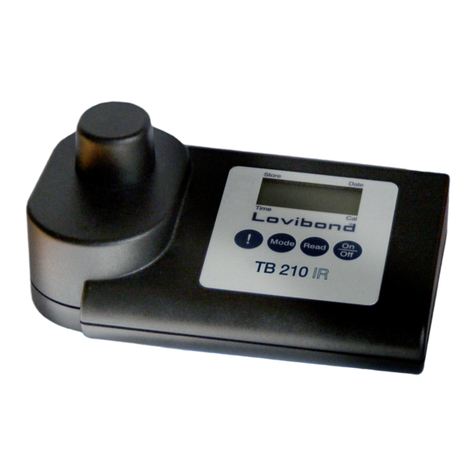
Tintometer
Tintometer Lovibond TB210 IR User manual
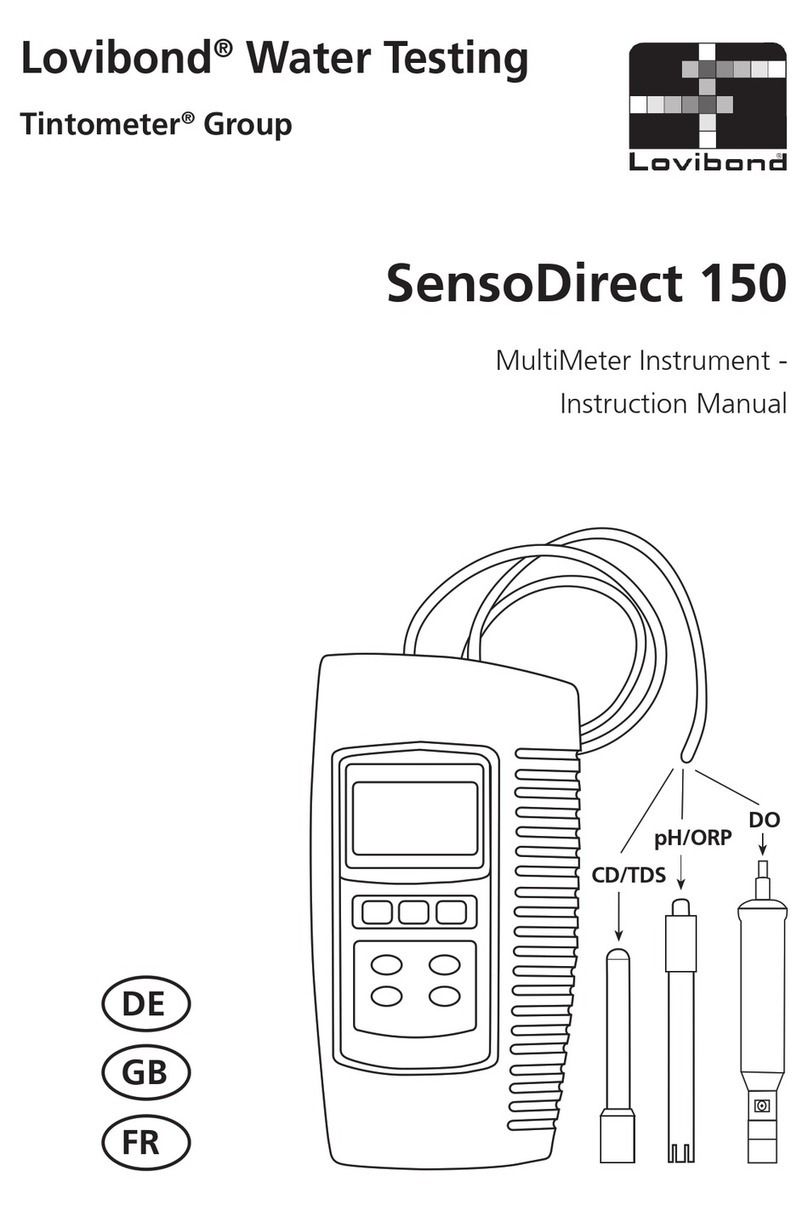
Tintometer
Tintometer Lovibond SensoDirect 150 User manual
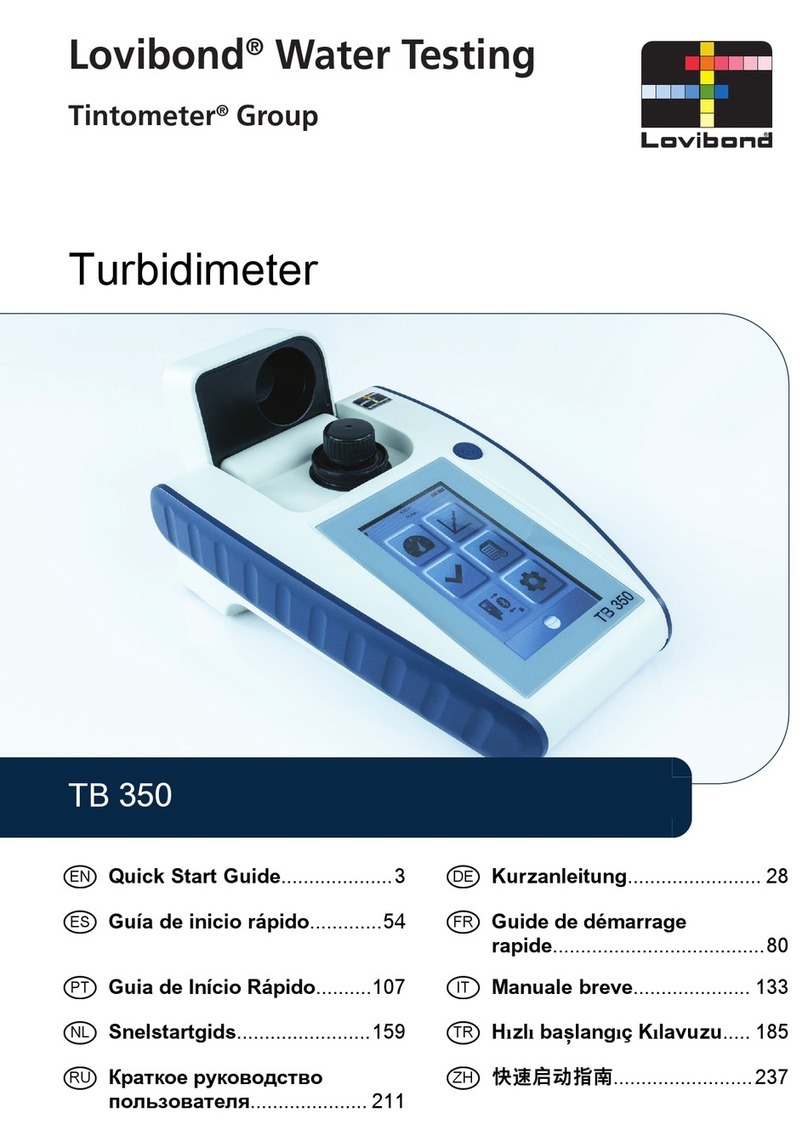
Tintometer
Tintometer Lovibond TB 350 User manual

Tintometer
Tintometer Lovibond SensoDirect pH110 User manual
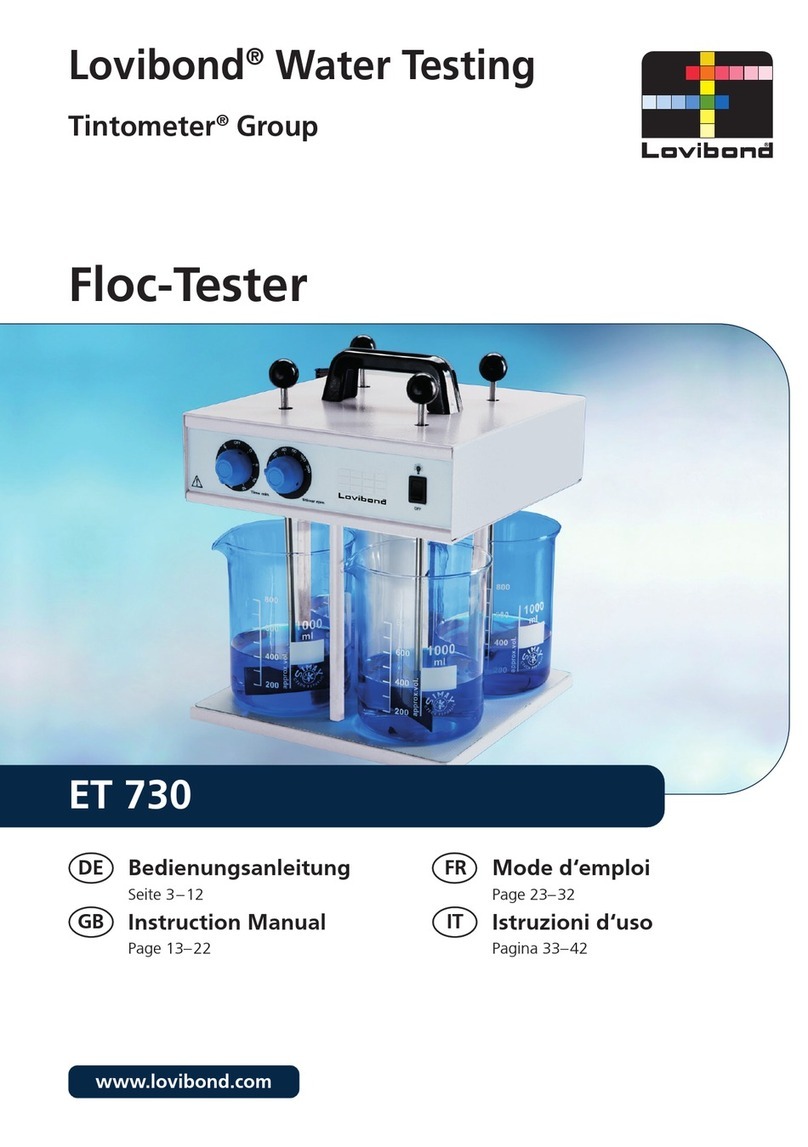
Tintometer
Tintometer Lovibond Floc-Tester User manual

Tintometer
Tintometer Lovibond TB 350 User manual
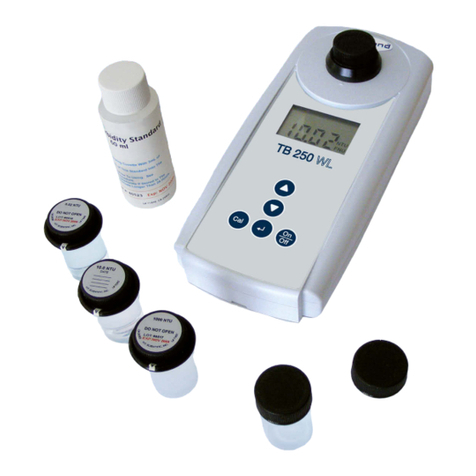
Tintometer
Tintometer Lovibond TB 250 WL User manual
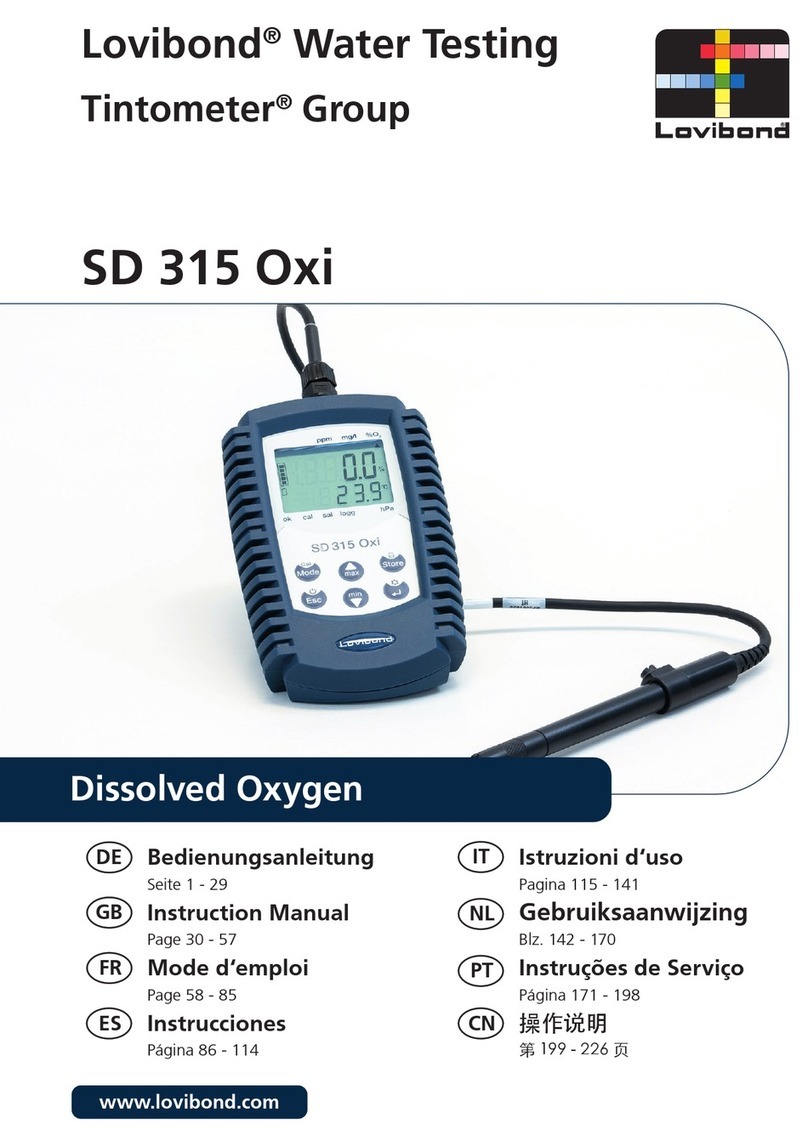
Tintometer
Tintometer Lovibond SD 315 Oxi User manual
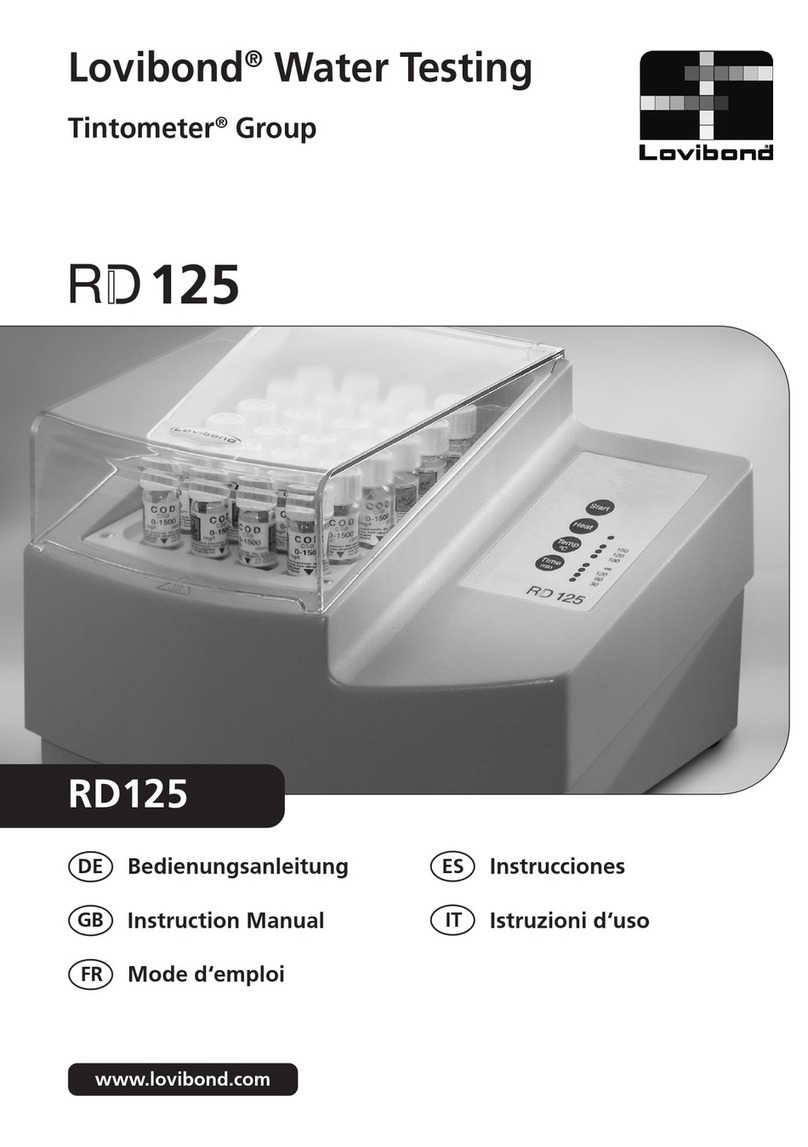
Tintometer
Tintometer Lovibond RD125 User manual

